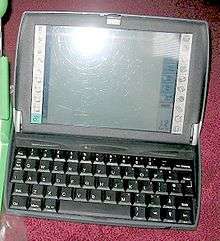Psion netBook
The Psion netBook is a small subnotebook type computer developed by Psion. Released in 1999, it was aimed at the mobile enterprise market.[1]

Description
Similar in design to the later, consumer-oriented Psion Series 7, the netBook has a clamshell design, a VGA-resolution touch-sensitive colour screen, 32 MB RAM, 190 MHz StrongARM SA-1100 processor and a QWERTY keyboard. The RAM is upgradeable through the addition of an extra 32 MB chip. The netBook is powered by a removable lithium-ion rechargeable battery, giving a battery life of between 8 and 10 hours.
The netBook runs the EPOC ER5 operating system (the predecessor of SymbianOS). Unlike the Psion Series 7, the netBook operating system runs from RAM. A Java run-time environment, conforming to Java version 1.1.8, is available.
In October 2003 Psion Teklogix announced the NETBOOK PRO, replacing the original netBook. This was similar to the earlier model, but upgraded with a 16-bit colour SVGA (800 × 600 pixel) display, 128 MB of RAM, and a 400 MHz Intel XScale PXA255 processor running Windows CE .NET 4.2 instead of EPOC.[2] It is also possible to run Linux on this model.[3]
An open-source project "OpenPsion", formerly "PsiLinux", ported Linux to the Psion netBook and other Psion PDAs.[4]
Included software
- Agenda – a personal information management program
- Bombs – a minesweeper game
- Calc – a calculator
- Comms – a terminal emulator
- Contacts – a contacts manager
- Data – a flat-file database program
- Email – an email, SMS and fax client
- Jotter – a multipage scratchpad
- NetStatRF – a WiFi card monitor
- Program – an OPL program editor
- Record – a voice recording program, for use with the in-built microphone
- Sheet – a spreadsheet and graphing package
- Sketch – a drawing program (for use with the touch-screen interface)
- Spell – a spellchecker, thesaurus and anagram program
- Time – a world clock and alarm program
- Opera – a web browser
- Word – a word-processor
The "Netbook" trademark
Psion registered the trademark NETBOOK in various territories, including European Union and U.S. Trademark 75,215,401, which was applied for on 18 December 1996 and registered by USPTO on 21 November 2000. They used this trademark[5] for the netBook product, discontinued in November 2003,[6] and from October 2003, the NETBOOK PRO, later also discontinued.[7]
Intel began use of the term netbook in March 2008 as a generic term to describe "small laptops that are designed for wireless communication and access to the Internet", believing they were "not offering a branded line of computers here" and "see no naming conflict".[8]
In response to the growing use of this term, on 23 December 2008 Psion Teklogix sent cease and desist letters[9] to various parties including enthusiast website(s) demanding they no longer use the term "netbook".[10][11]
During the twelve years since Psion first lodged the original netbook trademark, the term had become perceived as sufficiently generic that later derivative marks were rejected by the USPTO citing a "likelihood of confusion" under section 2(d), including "G NETBOOK" (U.S. Trademark 77,527,311 rejected 31 October 2008), MSI's "WIND NETBOOK" (U.S. Trademark 77,580,272) and Coby Electronics' "COBY NETBOOK" (U.S. Trademark 77,590,174 rejected 13 January 2009).
References
- Psion netbook news release, PR News Wire, archived from the original on 2011-06-08.
- Vogel, Sandra (2003-10-03). "Psion NetBook Pro: a first look". ZDNet.co.uk. ZDNet. Retrieved 2009-02-23.
- "OpenPsion". SourceForge..
- Psion netbook news release Archived 2011-06-08 at the Wayback Machine.
- Psion Discontinued Products Archived 2007-05-17 at the Wayback Machine.
- NETBOOK PRO Discontinued Archived 2011-01-04 at the Wayback Machine.
- Paul Bergevin – VP and GM of Intel’s Global Communication Group.
- Psion Cease and Desist Letter Archived 2009-03-26 at the Wayback Machine.
- jkOnTheRun.
- Psion threatens netbook sites over trademarks.
External links
- Psion Teklogix website
- Psion Teklogix – EOL products